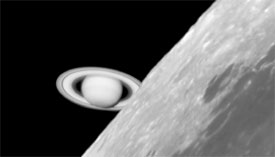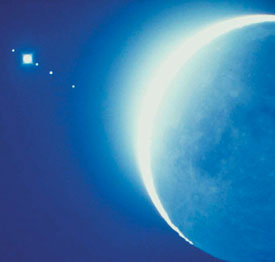
As Saturn was being occulted by the Moon on September 10, 2001, Ron Dantowitz and Marek Kozubal started logging images from the 60-inch Mount Wilson Observatory reflector to their computer’s hard drive. They acquired 7,168 individual 1/60-second exposures of Saturn and dozens more (1/250 second) of the brilliant lunar limb. The final composite gives a view of a Saturn occultation with unparalleled clarity.
Courtesy Ron Dantowitz and Marek Kozubal, Clay Center at Dexter and Southfield Schools.
In a small telescope you can occasionally see the edge of the Moon creep up on a star. The star appears to sit on the Moon's limb for a few seconds before suddenly vanishing.
Just as abruptly, about an hour later, it emerges from the Moon's other side. The startling suddenness of these events proves that the Moon has no atmosphere and also that stars have tiny angular sizes — smaller than could be measured any other way until recently.
Skywatchers everywhere should mark their calendars to enjoy the best of these occultations. Even more rewarding is timing them accurately, a simpler task than you might think. Very accurate timings of many occultations can be made by just pointing a camcorder into the eyepiece of a telescope (see "Camcorder Timing Tips"), and some stars are so bright that you don't even need a telescope at all.
When the Moon is waxing, on its way to full, stars almost always disappear on the Moon's dark limb, where they are easy to see. The reappearance happens on the bright limb, which overwhelms most stars with glare and makes them too hard to watch or time. When the Moon is waning, the events on the bright and dark limbs are reversed. Reappearances always take more care, since you need to be looking at the part of the Moon's limb where the star will emerge. A low power helps for bright stars.
Occultation Details

On August 18, 1990, the Moon occulted Jupiter and its satellites. From left to right in the Jovian system are Europa, Jupiter, Io, Ganymede, and Callisto. This photograph was taken just prior to the start of the occultation.
Courtesy Vic and Jen Winter.
In 2002, in a break from the past, we give information about occultations visible throughout the world. The emphasis is on events in North America, Europe , and Australia and New Zealand, where large numbers of active observers live. Only the brightest events can be covered here.
During 2002, the Moon will cover Jupiter and Saturn several times, as well as many 2nd- to 4th-magnitude stars. Also interesting will be occultations of Vesta, the brightest asteroid, and passages of the Moon through Messier 35 and other open star clusters. The tables associated with these events are available in the online version of this article in Sky & Telescope’s archive.
A grazing occultation is visible within a mile or so (2 or 3 kilometers) of an occultation's predicted northern or southern limit. By stationing yourself there, you might see the star wink off and on several times as it passes behind hills and valleys near the Moon's north or south pole. Observers spaced across this path will time different sequences of events, which can be analyzed to map the lunar-limb profile. Simple visual timings are fine for grazes because geographic location is a more important factor for them than extreme accuracy of timing. Grazes are needed for mapping the apparently ice-rich lunar polar regions, which the Clementine spacecraft's laser could not reach during its 1994 mission to the Moon.
Grazes are the most dynamic, interesting, and valuable kind of lunar occultation. The year's best grazes are shown on the maps in this article. Most require at least a small telescope. But just a camcorder with 24x or more zoom, or firmly mounted binoculars, might suffice for those that occur at night on the lunar dark side in North America on January 18th, April 20th, July 15th, October 3rd, and December 24th. The same is true for those in Europe on January 26th, February 21st and 23rd, April 16th, June 17th, and the four in September. Binoculars can also be used in Australia on May 4th and December 9th, and in New Zealand on October 11th and November 9th.
About two dozen grazes each year are visible in a 15-centimeter (6-inch) telescope within 150 km of a given location. Many are observed by organized groups of amateurs, which welcome newcomers. Contact the International Occultation Timing Association (IOTA) or other regional or national occultation organizations.
Occultations of Bright Stars for North America, 2002

An occultation can be seen north of a red line or south of a blue one. A grazing occultation occurs along each line; tick marks at 10-minute intervals (increasing west to east) indicate the Universal Time of the middle of the graze. A circled A means that the event is visible but the Moon's altitude is too low for reliable timings, S means sunrise or sunset for bright objects or shows where twilight becomes too strong, and B marks where a central graze occurs at the Moon's north or south cusp and terminates the path (unless the star is bright enough that it might be observed against the sunlit side of the Moon).
Source: Eberhard Riedel, David W. Dunham. Sky & Telescope illustration.
Occultations of Bright Stars for Europe, 2002

An occultation can be seen north of a red line or south of a blue one. A grazing occultation occurs along each line; tick marks at 10-minute intervals (increasing west to east) indicate the Universal Time of the middle of the graze. A circled A means that the event is visible but the Moon's altitude is too low for reliable timings, S means sunrise or sunset for bright objects or shows where twilight becomes too strong, and B marks where a central graze occurs at the Moon's north or south cusp and terminates the path (unless the star is bright enough that it might be observed against the sunlit side of the Moon).
Source: Eberhard Riedel, David W. Dunham. Sky & Telescope illustration.
Occultations of Bright Stars for Australia and New Zealand, 2002

An occultation can be seen north of a red line or south of a blue one. A grazing occultation occurs along each line; tick marks at 10-minute intervals (increasing west to east) indicate the Universal Time of the middle of the graze. A circled A means that the event is visible but the Moon's altitude is too low for reliable timings, S means sunrise or sunset for bright objects or shows where twilight becomes too strong, and B marks where a central graze occurs at the Moon's north or south cusp and terminates the path (unless the star is bright enough that it might be observed against the sunlit side of the Moon).
Source: Eberhard Riedel, David W. Dunham. Sky & Telescope illustration.

An occultation can be seen north of a red line or south of a blue one. A grazing occultation occurs along each line; tick marks at 10-minute intervals (increasing west to east) indicate the Universal Time of the middle of the graze. A circled A means that the event is visible but the Moon's altitude is too low for reliable timings, S means sunrise or sunset for bright objects or shows where twilight becomes too strong, and B marks where a central graze occurs at the Moon's north or south cusp and terminates the path (unless the star is bright enough that it might be observed against the sunlit side of the Moon).
Source: Eberhard Riedel, David W. Dunham. Sky & Telescope illustration.
For More Information
If you're interested in timing occultations, be sure to refer to the article "How and Why To Make Occultation Timings" elsewhere on this Web site. The complete article, including occultation tables for North America, Europe, Australia, and New Zealand, as well as more details about occultations of solar system objects and open clusters, is available in the Sky & Telescope online archive.
Predictions of occultations for 17 North American stations are given in the 2002 Observer's Handbook of the Royal Astronomical Society of Canada. About 30 occultations of stars as faint as 5th magnitude are listed for each location.
Walt Robinson (515 W. Kump, Bonner Springs, KS 66012-1439 USA) will compute occultation data if you send him accurate geographical coordinates and an e-mail address or a long, self-addressed, stamped envelope. European residents should instead contact Hans Bode, Bartold-Knaust Strasse 8, D-30459 Hannover, Germany.
The International Lunar Occultation Center (Tokyo), which prepared the predictions for the Observer's Handbook, also collects and analyzes timings. Reports can be sent to them by e-mail. Obtain report forms and instructions from IOTA's Web site.
Annual membership in IOTA costs $30 in North America ($35 overseas) and includes free graze predictions for stars brighter than 9th magnitude, local circumstances for the approaches of asteroids to stars, descriptive materials, and a subscription to the Occultation Newsletter (available separately for $20, more overseas). A Web-based membership is available for $15.
 0
0
Comments
You must be logged in to post a comment.